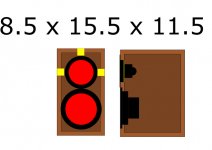Hi folks,
Due to an incoming project with a waveguided DX25 tweeter within a WG148 Visaton, I'm asking myself the following questions.
-The speaker will be wide baffle. Will the width act as expansion of the waveguide, bringing it's effectiveness further to lower frequencies?
-Is it necessary/beneficial to offset the tweeter despite the waveguide to fight diffractions?
Best regards,
Alexander
Due to an incoming project with a waveguided DX25 tweeter within a WG148 Visaton, I'm asking myself the following questions.
-The speaker will be wide baffle. Will the width act as expansion of the waveguide, bringing it's effectiveness further to lower frequencies?
-Is it necessary/beneficial to offset the tweeter despite the waveguide to fight diffractions?
Best regards,
Alexander
Hi,
About your first question make a search for Patrick Bateman's threads relative to this ( and rounded edge for faceplate). What do you call large width?
About second flush mounting of waveguide and no edge ( roundover) will help about diffraction for sure but it'll depend from radius of roundover and frequency of interest. Here again Patrick Bateman experimented a lot with this and you will find some answers from him. Earl Geddes loudspeaker design is worth a study too ( and read of his whitepapers).
About your first question make a search for Patrick Bateman's threads relative to this ( and rounded edge for faceplate). What do you call large width?
About second flush mounting of waveguide and no edge ( roundover) will help about diffraction for sure but it'll depend from radius of roundover and frequency of interest. Here again Patrick Bateman experimented a lot with this and you will find some answers from him. Earl Geddes loudspeaker design is worth a study too ( and read of his whitepapers).
Last edited:
I am doing a xt25 with the w148 also. Roundover, unless they have a radius over 2 " do not do much. i have chosen a skinny baffle for my first prototype, a 8.5 wide for a 6.5 inch woofer.
In as much as I understand, with waveguides if you wnat to have good directivity, offsetting is not the way to go. I am going to flush mounted to help with diffraction. First two way for me and I am at the measurements phase now. Following the vituixcad cad workflow. The case soft has a tool to simulate the effects of different baffles. Kimi encourages to run with simulations.
In as much as I understand, with waveguides if you wnat to have good directivity, offsetting is not the way to go. I am going to flush mounted to help with diffraction. First two way for me and I am at the measurements phase now. Following the vituixcad cad workflow. The case soft has a tool to simulate the effects of different baffles. Kimi encourages to run with simulations.
Last edited:
A waveguide designer isn't likely to choose the offset method, even though they could resonably enough. Offsetting a driver is about keeping diffraction but mixing it up whereas a waveguide designer is more likely to try to reduce it using a suitable profile and termination. Working in the middle of a baffle gets the most out of it with regards to lower frequency extension. The offset method tends to look better on one axis but not overall.
